


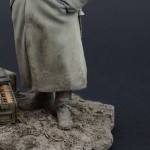
Bavarian MG08 Gunner ca. 1915 FLAMGA – Flieger Abwehr MG Abteilung
- Scale / Maßstab: 1:16
- Approx. height of figure: 114mm
- Material: Resin (figure), Model Plaster (base) / Resin (Fugur), Modell-Gips (Sockel – synethetische, kunststoffveredelte Gießmasse)
- Parts: See Below
- Infosheet / Infoblatt: English
- Code: 26MGP
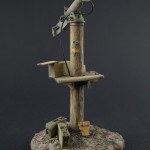
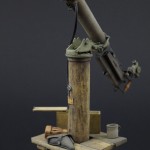


Contents Figure / Inhalt Figur:
- Figure (3 parts) / Figur (3 Teile)
- Head with Spiked Helmet M1895 (3 parts) / Kopf – Lederhelm mit Spitze M1895 – Pickelhaube (3 Teile)
- 2nd Alternative Head with Prussian Shako Model 1895 (3 parts) / 2. Alternativ-Kopf mit Preußischen Tschako Modell 1895 (3 Teile)
- Canvas Gas Mask Holder / Segeltuchtasche für Gasmaske
- Haversack M1887 / Brotbeutel M1887
- Water Bottle M1907 / Feldflasche M1907
- Bayonet M1898/1905 / Seitengewehr M1898/1905
- Leather Case for ZF 12 Sight / Futteral zum ZF 12
- Metal Cup M1916 / Tasse M1916
- Leather MG Dragging Strap / MG-Schleppgurt (cast on body and haversack)
- Luger Pistol 01 / Pistole 01 (oder P01)
- Steam Condensing Can old type (3 parts) / Kühlwasserbehälter alter Art (3 Teile)
- Figure Base / Figur-Sockel
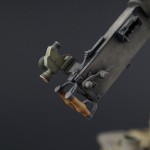
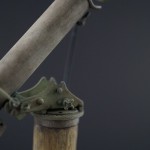


Contents MG08 / Inhalt MG08:
- MG08 (8 parts) / MG08 (8 Teile)
- Prismatic Optical Sight Model ZF 12 (2 parts) / Zielfernrohr ZF 12 (2 Teile)
- MG Water Jacket Shield / MG Mantelpanzer Vorne
- Trench Mount for MG08 (12 parts) / Hilfslafette oder Grabenlafette für MG08 (12 Teile)
- Steam Hose (2 parts) / Dampf-Schlauch (2 Teile)
- Double-Ended Metal Spare Barrel Container for MG08 / Ersatzlaufbehälter für 2 Rohre MG08
- 2 x Ammunition Boxes M1911 / 2 x Patronenkasten M1911
- Ammunition Box M1911 Open (6 parts) / Patronenkasten M1911 Offen (6 Teile)
- 2 x Ammunition Boxes 15 / 2 x Patronenkasten 15
- Wooden Ammunition Box M1901 – Open (3 parts) / Patronenkasten aus Holz M1901 – Offen (3 Teile)
- Wooden Ammunition Box M1901 / Patronenkasten aus Holz M1901
- Empty Ammunition Cases / Leere Patronenhülsen
- Tree Trunk for mounting MG (2 parts) / Baumstam zum MG montieren (2 Teile)
- Model Base / Modell-Sockel
- Spare Parts for MG-Mount, MG & MG-Fixing Assembly / Ersatzteile für MG-Grabenlafette, MG & MG-Befestigung

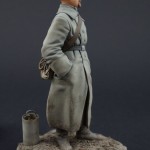

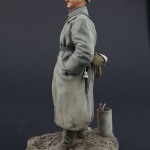
Extracts from the Infosheet with this figure:
The first MG Detachments were formed in 1901 and by the outbreak of the war in 1914 a total of 11 independent Maschingewehr-Abteilungen were listed. Parallel to the MG Detachment, which were attached to Cavalry Divisions, new MG companies were formed within the Infantry Units, being traditionally the Regiment’s 13th Company. Some regiments formed a 14th company, which became the Fortress MG Company / Festungs MG-Kompanie.
The figure depicts a machine gunner attached to the 14th Bavarian Infantry Regiment, stationed in Nurnberg (German spelling Nürnberg). The original idea for this figure came from an early wartime group photograph of this unit during their stay in the barracks in Nurnberg.
The figure can be made up on the single base provided, with the MG condenser can positioned behind or alternately displayed with the MG08 mounted on a tree trunk in the anti-aircraft role. Both bases are designed to fit together.
Head 1: This depicts a young man just finishing his training. He wears the Spiked Helmet M1895 and is smiling at the camera.
Head 2: The alternative head is of an older soldier wearing the Prussian Shako Model 1895, associated with the MG-Detachments. He sports a small fashionable beard, typical of the time.
Uniform
Spiked Helmet M1895 with Cover / Lederhelm mit Spitze M1895 mit Überzug: Popularly known both in English and German as a `Pickelhaube´. The correct name translated is `Leather Helmet with Spike´. This type of headwear dates back to 1842 and was made out of leather, with the spike, emblem and rim edges in brass. They gave no protection whatsoever during combat. On the front is the state emblem and each side where the chin- strap is attached are the two Kokarden. Right side – Reichskokarden: Imperial cockade. Left side Landeskokarden: State cockade. The chin- strap is on top the helmet cover. In the field these helmets were protected with a cotton cover.
Within the first few months of the static trench warfare, troops were removing the spikes and tucking the remaining excess cloth into the (ventilating) hole. From approx. mid 1915 helmet covers were issued without the spike material. On the figure the spike has been made separately, allowing the helmet to be shown, as it would have been in a front line area at the beginning of 1915. The cover has 4 seams running from top centre of helmet to edge / bottom.
Prussian Line Regiments, (apart from Guards) applied unit numbers in red onto the front of helmet covers. Shortly after the out- brake of war a new directive (in Bavaria on 04.09.1914) stated that all numbers and the letters “R” for Reserve and “L” for Landwehr regiments were to be in a less conspicuous light green. Later, a green cloth was used. Colour: Cover – rush-green (in practice these covers would fade within a short time and the result was a light beige, or grey colour). Chin strap – The standard brown leather chinstrap with two adjustable brass buckles (later steel or matt grey painted steel) lies on top of the helmet cover.
Other Ranks Shako M1895 with Cover M1915 / Mannschafts-Tschako M1895 mit Überzug M1915: The standard shako for other ranks, generally associated with the German Light Infantry Regiments such as Jäger and Schützen, but also worn by Machine Gun Detachments (only in Prussia and Saxon Units), Telegraph – Signal, Air Service (including Airship) and Transport Units. Up until 1854 Jäger battalions had worn the Pickelhaube and it was not until the 1950s that the last shakos were being phased out in the West German Police Force. As the war progressed and particularly after 1916, fighting units were issued the steel helmet and shakos were seldom seen within the front line areas. The cover was worn on active service with the chin strap either behind or on top. The helmet cockade or field badge / Feldzeichnen made out of cloth covered wood was still affixed to the top of the shako during the first months of the war, but discouraged by many front line Units thereafter (officially stopped as per German Army Regulations / AKO 21.09.1915).
Made out of black painted leather with the seam running down the front and behind the helmet plate badge. The helmet form tapered slightly towards the top and the rear and was shaped to the head. It had an oval leather top stitched to the body, with gloss black painted brass vents directly underneath, at the sides, each with 6 holes. The front and rear visors were made out of thick leather and had a black polished finish. The natural leather interior had a 9-finger liner tied in the middle with a cord. The shako cover has one seam running around the top and a second running from the field badge to end of front visor. In Prussia and Saxony, the MG-detachments wore a grey-green shako cover and from 15.08.1914 the detachment No. was to be applied in green.
The standard brown leather chinstrap with two adjustable brass buckles (later steel or matt grey painted steel) lies on top of the helmet cover. The two strap attachments on each side were normally of the same material as the buckles.
Neck Band / Halsbinde M1914: Designed to soak up the sweat and at the same time keep the field service dress or overcoat collar clean. Between the overcoat collar and the neck on the figure one can make out the Neck Band M1914. This was the replacement to the M1907 Neck Cloth, a square piece of material, which produced problems when the wearer was marching, actually causing the garment to tighten up around the neck. The neck band on the other hand was smaller and not unlike a detachable shirt collar, with a semi-circle apron of material attached underneath. Colour: these neck bands varied in colour from grey, light- grey to grey- green.
Grey Overcoat for Mounted Troops M1904 / Mantel für Berittene M1904: The standardized field grey coat M1904 for mounted troops (in Bavaria M1909) and was also issued to the field artillery, train (supply) units and MG detachments. This other-ranks coat was longer than the standard M1894 for infantry and had the following differences:
- Incorporated in the back area there was a 7 cm fold in the centre, which was sewn together below the collar and ended at the waist
- The rear, bottom slit ended at 15 – 20 cm below the waist and was longer than the coat issued to foot troops (required when on horseback)
The removal of the shoulder straps was a step taken at the beginning of the war, but not with all units. In some cases and with the original photo, the straps were never fixed to the coats. Colour: in 1915 the coats were of the same field grey as that of the infantry. The buttons were of Tombak (an alloy of copper and zinc, which had a matt bronze/yellow colour) or on pre-war coats brass.
Infantry Boots M1866 / Infanteristiefel M1866: The nailed infantry boots for other ranks were made out of leather and had a tendency to `winkle´ down around the ankles after being worn in. Depending on size they had between 35 and 45 nails in the sole and reinforced heel. On each side of the boot shaft are seams where the front and rear of the leather are joined together. Colour: at the beginning of the war the boots had a natural light tan, which was then often darkened by coats of dubbin. As per Army regulation September 1915, boots (and much of the other leather equipment as well) were issued in blackened leather.
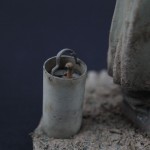

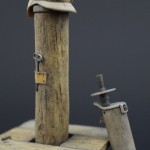

Equipment
Belt M1895 / Koppel M1889: From late 1915 onwards, belts were issued blackened, with a grey buckle. Up until then most leather equipment was issued in brown. Within the first few months of the war, belt buckles were being painted over in grey.
Company Bayonet Knot / Kompanie-Troddel: These enabled the wearer’s company to be identified and were attached around the bayonet frog. Up until 1915/16 German infantry regiments wore the bayonet knot to distinguish the 12 companies within an infantry regiment. The MG Company at this time was traditionally the 13th. The knots were phased out from mid-1916, the latter Troddel being produced from inferior quality cotton, with the base white colour appearing light grey or off-white. Surplus stocks were still being issued up until the end of the war. Colour: the knots of the 13th MG Company were white, apart from the blue stem between small & large bobble.
MG08 Dragging Strap / Tragerriem zum MG 08 or MG-Bandelier: This is an early-model dragging strap with the simplified ring and hook attachments and was worn by MG crews throughout the war. These straps were principally used to drag the MG or ammo cases in the field and in some cases even in the prone position. Later the straps were manufactured from canvas due to the shortage of leather. Colour: strap – brown leather, outer metal ring – brown leather (covered steel), metal hook – steel.
Haversack M1914 / Brotbeutel M1914: Also known as the bread bag. Made out of a canvas material and generally used for rations etc. It was a popular place to keep the spare gas mask filter. The small leather fastening strap on middle left side is to fasten the water bottle, avoiding any unnecessary movement. Colour: grey- brown or khaki canvas colour, buttons – zinc, small leather straps – brown.
Water Bottle / Feldflasche M1907: This had a capacity of 0.8 litres and was attached to the haversack/bread bag by means of a leather strap and buckle. Originally made from aluminium, later Ersatz material and covered with a brown felt material. On one side are the four metal snap fasteners, which were either left blank or painted over in grey. It was quite common for front line troops, particularly during combat periods to carry a second water bottle. The screw on top was in aluminium.
Metal Cup M1916 / Tasse M1916: The enamelled steel cup replaced the earlier aluminium version (production was discontinued in October 1914 due to lack of aluminium) and can be fixed to one of the bread bag fastening straps. The opposite end to the handle is a small indent in the rim to allow the cup to be used as a small jug. The official place for this cup was inside the bread bag. Colour: light olive green / field-grey.
Note: I have seen various photos of this item being fixed to the bread bag fastening strap above the water bottle – the handle may need to be cut open, depending on where it is fixed.
Canvas Gas Mask Holder / Segeltuchtasche für Gasmaske: In 1915 a canvas gas mask holder was issued with 2 dividing partitions within, which stowed the mask, filter and reserve-filter in a metal tin. The holder was generally worn either attached to the belt below the rucksack at the rear, or on the right side / front by means of 2 belt loops made from the same material and fastened with zinc buttons. Later versions of the holder had ring attachments on each of the belt loops enabling the fixing to the bread bag. Although generally used in the early part of the war, late war photos still show troops issued with this holder. The No. 2 at one end of the holder is the gas mask size and this has been modelled slightly raised to enable easier painting. On the model, part of the flap has lifted to reveal one side of the metal tin containing the spare filter. Colour: canvas holder – light grey- brown, number – dark coloured stamp colour – could have been black (on the original items these numbers are quite faded), filter tin – grey-green.
Weapons
Bayonet M1898/1905 / Seitengewehr M1898/1905: This was the so called butcher bayonet, with the distinctive wide blade at the top, near the point. The handle had a wooden grip, with 9 carved angled notches on each side for better grip and the sheath was black. Just above the guard (where the blade starts) is the lubricating hole for the locking mechanism. The bayonet frog – Seitengewehrtasche – would have been natural brown leather, later in the war blackened.
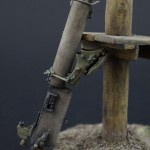
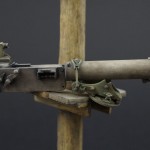


Maxim Machine Gun 08 / Maxim Maschinengewehr 08:
The follow parts make up this model (from the front to rear with colours of items):
- Muzzle Assembly (Flash Cone, Booster) – gun metal black
- Flash Shield – gun metal black
- Armoured Front Plate – field grey
- Cooling Jacket (Barrel) – issued in gun metal black (on occasion painted grey-green)
- Steam Condenser Attachment – brass
- Steam Condenser Hose – dark grey / grey
- MG Block – gun metal black
- Crank Handle – gun metal black
- Sight Mount – gun metal black
- ZF12 Sight – field grey or green housing, brown eyepiece, black optic
- ZF12 Sight Optic Cover – field grey or green with brown leather strap
- MG Spade Grips (Handles) – wood colour grips, rest in gun metal black
Germany’s heavy machine gun the Maxim 08 stems from Sir Hiram Maxim’s original invention and was manufactured initially under license by the Berlin based firm Deutsche Waffen & Munitionsfabriken (DWM) as the MG01 in 1901. By 1903 a total of 13 independent Machine Gun Detachments / Maschingewehr-Abteilungen had been formed, each with six horse-drawn MGs and supporting elements. In 1908 the MG was adopted by the German Army along with the unique sled mount – hence the MG08. By 1913 a total of 100 MG Companies had been formed, incorporated directly within the infantry regiments (the 13th company of a 12 company regiment). At the outbreak of war in September 1914 every active infantry regiment had its own MG Company, leaving some Reserve and most of the Landwehr Units without. MG companies would take on the uniform of their parent unit.
The MG was water cooled and could fire up to 400 rounds per minute using the 250-round fabric belts up to a maximum range of 4,400 yards. Although originally intended as a quick reaction weapon and attached to cavalry divisions, it was in the defence roll, when dug-in a trench system that the weapon proved to be most deadly.
The steam condenser hose attachment, which fits on the front left side of water jacket. The attachment has been modelled with both the hose and jacket connections together as they would appear when the hose is attached.
MG Water Jacket Front Shield (sometimes called Face Plate) – the front jacket shield was the most commonly seen part of the MG’s set of armour. This fitted over the off-set post sight and around the muzzle. The bottom fold in the plate is to allow the attachment of the steam condenser hose. A full set of MG08 jacket armour with gunner’s shield is also available from the JSM range.
Colour: the handle grips are hard dark wood (may well have been somewhat lighter when first issued). The steel parts to the MG08 were treated in the bluing process (German – Brünieren) primarily as a protection against rust. This gave a blue-black appearance. In some instances only the water jacket was painted a grey-green as this was the only part of the MG visible when dug in or installed within a bunker. The muzzle section (flash cone, booster), which was also applied the bluing process, were during longer periods of action additionally covered in soot.
The different camouflaged patterns, more associated with the German steel helmets was later applied on occasion to the lighter MG08/15, but to date I have not come across an original WWI photo of this paint scheme to the MG08.
Tips:
Keep the gun handles on the casting block whilst removing the excessive resin / mould lines.
The separate crank handle is to be attached to the rear right hand side of the MG block. This can be achieved by drilling out the attachment hole (1mm drill) and inserting the crank to move freely if required (during firing the handle moves in a half cycle backwards and forwards).
Using a small drill and a knife it is possible to hollow out the space inside the breach block, allowing an ammunition belt to be placed into the opening if required – here the resin has been cast as thin as possible. This can also be applied to the trigger assembly at rear of MG before attaching the handle grips. Below the actual trigger is a ring, which can be drilled out. On these early / wartime MG08s there is also a hole directly behind the ring, going into the rear of the MG block – this can likewise be drilled out (this allowed the barrel to be cleaned without removing it from the water jacket).
The small armoured front shield should be fixed to the gun before the muzzle assembly is added.
The flash cone has already been cast with an opening at the front. This can if required be drilled out further and the inner cone wall thinned out.
The flash shield will slide over the cone and sits on a round lip behind.
Under the rear site slide bar on the main MG block there is a small casting web – this should be removed.
Prismatic Optical Sight ZF12 / Zielfernrohr ZF12: The standard sight for the wartime MG08s. Under the ZF12 sight mount there is a casting web around the fixing lever – this needs to be removed. The protection lens cap for the optic was attached to the sight housing with a small leather strap. The sight housing was of steel, with the upper lens and adjustment wheel in brass, these were issued with a field grey or green application.
Leather Case for ZF12 / Lederköcher für Zielfernrohr ZF12: The leather holder for the ZF12 has been supplied as an extra and would normally be carried by the gunner. The Prismatic Optical Sight ZF12 was the standard sight for the wartime MG08s. Colour – brown leather.
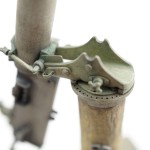
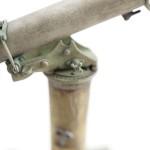
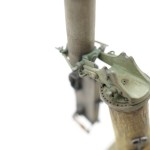
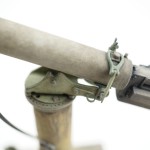
MG08 Trench Mount / MG08 Hilfslafette:
The trench mount was essentially an auxiliary device to allow this heavy MG to be mounted either on a wooden board with gripping spikes for ground targets (see above) or to a tree stump / post in the anti-aircraft role or FLAMGA (Flieger Abwehr Maschinengewehr Abteilung). The standard sled mount or Schlitten 08 was too large and cumbersome to be affixed in this way (there is however photographic evidence of the sled mounted MG08s incorporated onto wooden frame works or upturned wagon wheels for this purpose). Curiously, when the MG is mounted onto the rear AA position, it does not allow for horizontal fire, due to the cooling jacket being wider than the gap between the mount sides. However, there are photographs showing alterations to the top half of these mount sides i.e. bent outwards, presumably carried out at local or unit level. The mount base plate would be bolted to the trunk / post or wooden board with the mount rotating freely over the bolts. When the lighter MG 08/15 appeared in sufficient numbers from late 1916, these trench mounts, at least in the ground-fire role gradually disappeared. Colour: field grey or green.
On each side of the mount are 2 locking bolts – here there are casting webs attached and require removing. This is quite a complicated contraption in this scale model and care should be taken before fixing the parts together. Some online photographs of trench mounts in museums or private collections are unfortunately showed with various parts affixed wrongly. One should seek original WW1 photographs or check out www.mg08.de (German language) – here there are accurate pictures of this piece of equipment as well as other MG08 & MG 08/15 accessories. Alternately the JSM website shows a number of photographs with the details of the assembly.
Note: the 2 x fixing hooks fit onto the bottom clamp axle on each side, allowing the gun to elevate freely. The clamp screws then fit over the top, joining both clamps. The fixing hook openings face to the rear on the FLAMGA MG mount version and to the front on the ground target version. The 2 x locking fasteners then hold the hooks in place.
Spare Parts for Mount & MG Fixing Assembly: Due to the partly complicated type of model this MG08 presents, a small bag of spare parts is also supplied with this kit. The extra parts are mainly associated with the MG trench mount, fixing section to the gun and MG, which maybe misplaced or broken during construction.
Cylindrical Water Condenser 1st Model for MG08 / Wasserkessel (1. Modell zum MG 08): Named the water bucket / Wassereimer by the German MG crews and used to collect the condense steam generated by the sustained firing of the MG and to refill the cooling jacket afterwards. The steam hose end had to be submerged in to at least ¼ of the can’s contents, otherwise the steam would vaporize. The spout could be locked in the upwards position by the handle or folded down and locked underneath when not in use. Today these cans are amongst some of the rarest items for any MG08 collector. Colour: the spout, ball valve and filling screw cap were of brass on these early models (later in steel), condenser can – gun metal or painted grey.
Note: the water container handle can be carefully thinned out and fitted into the attachment-holes at the top of can. Both holes should be drilled out beforehand (0.5 mm).
Rubber Steam Hose / Dampfschlauch: The 2 m rubber steam hose is attached onto the hose-attachment on the front underside of water jacket and is to extract the vaporized water, which is then collected within the water container / can. The end of the hose would be placed in the opening under the filling screw cap (not on the spout end, which is too small). Firing from a trench, or fixed position the MG crews, provided that they had a sufficient water supply, were instructed in the MG08 hand book to dig a small whole and bury the end of the hose to one side of the gun, thus avoiding the rising white plume of steam giving their exact position away. Colour: varied in colour from grey to dark matt coloured rubber – not quite black.
About half the photos of FLAMGA / AA MGs positioned on posts are without the steam hose altogether and in some cases the hose is attached, but rapped loosely around the post.
Wooden Ammunition Box M1901 / Holz Patronenkasten M1901: The wooden ammunition box held a 250 round woven cotton belt with brass spacers and was used for both the MG08 and the MG08/15 (although the belts were different). A push-in fastener held the lid closed with the metal handle folding into the crevice of the lid. Early models had brass handles, hinge fittings etc., later these were produced in steel. Colour: The boxes, which I had looked at had been painted originally in grey-green, with of cause the edges to the boxes quite worn. Stenciled on the lid in black were sometimes a single arrows, indicating the direction that the box should be placed next to the MG.
One ammo box supplied has a detachable lid – the strips of ammunition can be painted separately and placed inside the open box afterwards. The last / top inlay has the brass bound feed tab – in this case for the lighter MG 08/15 gun. Plywood was used in making the original master ammunition box in order to maintain the wood grain surface structure.
Ammunition Box 11 / Patronenkasten 11: The double belt ammunition box produced in galvanized sheet metal (known colloquially as PK11 – PatronenKasten 11). As on the PK 15, the metal carrying handles were widened where the hand would grip to give added ease whilst carrying. The handles all fold back snug within the lid inlet. The internal dividing wall was in some cases removed to enable the ammunition box to function as a tool or spares container. Colour – outer: green / grey. Inner: galvanized steel. These ammo boxes showed often a battered appearance on original photos with the corners and tops particularly worn.
Ammunition Box 15 / Patronenkasten 15: as in the Ammunition Box 11, but for single belt only. Colour – outer: green / grey. Inner: grey.
Pistol 08 / P 08 (or Luger – the Germans never called this weapon the Luger – this is an anglicised name): The P 08 was first produced in 1900, with the German military taken it on in 1908 – hence the Pistole 08. As a service pistol it had its drawbacks, mainly it was expensive, difficult to produce and susceptible to dirt. Experienced front line NCOs and men preferred the larger or chunkier pistols as opposed to smaller pistols used by officers. Colour of holster: blackened leather.
MG Stand & Base
MG08 FLAMGA Model Base: the base has been designed to either stand alone or fit together as one small vignette with the JSM Bavarian Gunner figure. The ground work is littered with spent cartridges, partly trampled into the surface. There are two indent areas on the base to accommodate the small type M 15 ammunition boxes if wished.
On the finished base I mixed in brass painted spent cartridges to the applied mud (a mixture of plaster, dried filter coffee and model paint). I added more cartridges during the final phase of painting.
When working with modelling plaster it is always advised to file and sand rather than cut or clip as this could lead to larger parts breaking off.
Tree Trunk: To mount the MG in the anti-aircraft position a steady fixture would have been required. A suitable tree trunk or post would have been dug into the ground. The metal ring at the top was to stop the trunk from splitting and would have been fitted locally. The trunk / post can only be fitted in a certain direction into the base.
Wooden Shelf: Built locally by the MG crew or Unit Carpenter and is to allow the placing of ammunition boxes closer to the gun. Some of the nails are still visible and one or two have not been hammered incorrectly into the wooden planks and are now bent over. There will of cause be the odd oil stain etc. on the shelf from maintenance of the gun and spillage. Colour: most wood types if untreated will eventually turn grey.
The shelf will slip over the post from the top and rest on the attachment plugs set on the tree trunk. The shelf is intended to have a slight slant to one side.
MG Cartridge Retrieval Tongs / Greifzange 16 (G): attached to the trunk, behind a strip of nailed on metal is the cartridge tongs to enable a quick removal of any jammed cartridges within the MG breech during a stoppage.
I have seen these tongs attached to the posts on an original photo of two FLAMGA / AA MGs mounts.
Empty 7.92 mm Cartridges / Leere 7.92mm Patronen: these can be placed on the self / ground as wished. Colour: brass.
Notes from the Sculptor
The MG08 was in reality a complicated weapon with many additional accessories to keep the gun in operation. To achieve a good reproduction as a model it was also necessary to produce many small and complicated parts. A small bag of spares with duplicated parts has been supplied with the kit, which I believe may help the model-maker with some of these intricate parts.
I have also added the correct German names of equipment / weapons etc. within this infosheet. This will enable further reference research if required on the many German collector / museum websites.
 An deutschsprachige Interessenten:
Sie können mich per eMail oder Telefon auch gerne auf deutsch kontaktieren. Ortsbesuch ist nach Absprache möglich.
An deutschsprachige Interessenten:
Sie können mich per eMail oder Telefon auch gerne auf deutsch kontaktieren. Ortsbesuch ist nach Absprache möglich.
